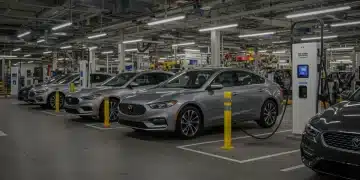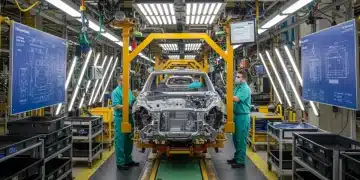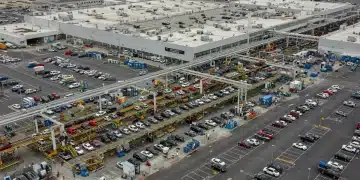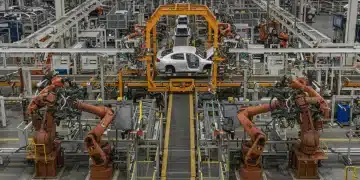US Auto Industry Labor Trends 2025: A Deep Dive
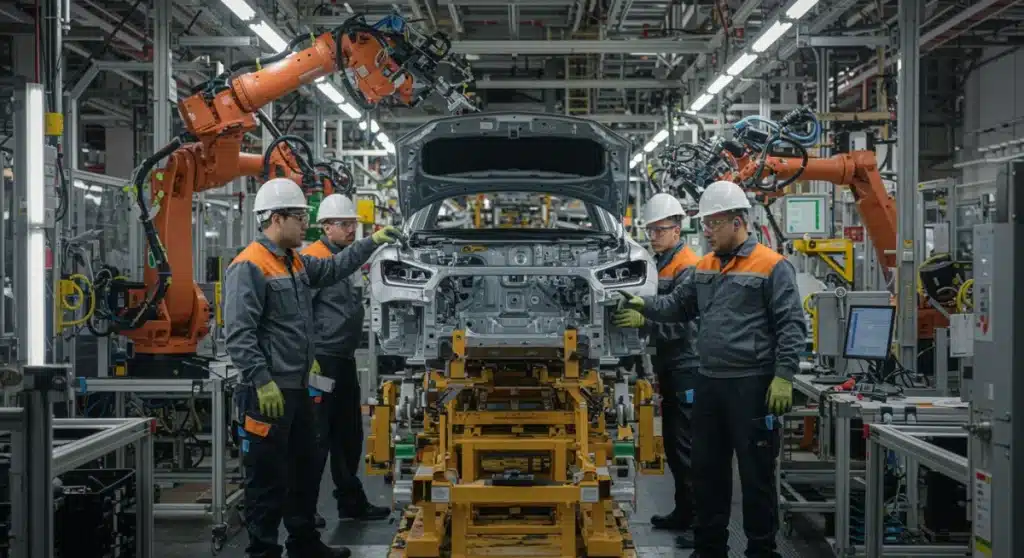
The US auto industry’s labor market in 2025 is poised for significant shifts, influenced by electric vehicle manufacturing, evolving skill requirements, and the persistent impact of union negotiations on employment and compensation structures.
Beyond the Headlines: A Deep Dive into the US Auto Industry’s Labor Market Trends for 2025 reveals a sector in flux, navigating unprecedented technological shifts and economic pressures. What challenges and opportunities lie ahead for workers and manufacturers as the industry races towards an electrified future?
The Accelerating Shift to Electric Vehicles and Workforce Impact
The transition to electric vehicles (EVs) continues to be a dominant force reshaping the US auto industry. This fundamental change is not just about product development; it’s profoundly altering the demand for specific skills and the overall composition of the automotive workforce. As of late 2024, major automakers are accelerating their EV investments, directly impacting labor requirements for 2025 and beyond.
Traditional powertrain manufacturing, which historically employed a significant portion of the workforce, is seeing a gradual reduction in labor demand. Conversely, the need for specialized skills in battery production, software development, and advanced electronics integration is surging. This creates a critical skills gap that the industry must address proactively.
New Skill Demands in EV Manufacturing
The manufacturing process for EVs differs considerably from internal combustion engine (ICE) vehicles. This divergence necessitates new competencies across the production line, from design to assembly. Companies are now focusing on upskilling and reskilling programs to prepare their existing workforce.
- Battery Technology Expertise: Knowledge of cell chemistry, battery management systems, and thermal management is crucial for EV production and maintenance.
- Software and Electronics Integration: As vehicles become more like computers on wheels, proficiency in embedded systems, cybersecurity, and advanced driver-assistance systems (ADAS) is in high demand.
- Robotics and Automation: The increased automation in EV plants requires technicians skilled in programming, operating, and maintaining complex robotic systems.
- Lightweight Materials Engineering: Expertise in advanced materials like aluminum and composites is essential for optimizing EV range and performance.
Union Dynamics and Collective Bargaining in 2025
The landscape of labor relations in the US auto industry remains highly dynamic, with the United Auto Workers (UAW) playing a pivotal role. Following significant negotiations in late 2023, the impacts of new collective bargaining agreements are expected to fully manifest in 2025, influencing wages, benefits, and working conditions across major manufacturers.
The UAW’s push for improved compensation and job security, particularly regarding EV production, has set new precedents. These agreements often include provisions for transitioning workers to EV-related roles and addressing potential job displacement due to automation. The ripple effects extend to non-unionized segments of the industry, which often adjust their own compensation structures to remain competitive.
Key Areas of Union Focus
In the lead-up to 2025, union strategies continue to evolve, adapting to the industry’s rapid transformation. Their focus areas highlight the ongoing challenges workers face and the UAW’s commitment to protecting its members’ interests.
- EV Plant Inclusion: A primary goal for the UAW is to ensure that new EV battery and assembly plants, many of which are joint ventures, are unionized and covered under master agreements.
- Wage Parity: Efforts persist to achieve wage parity for workers in EV-related facilities with those in traditional ICE plants, addressing historical pay discrepancies.
- Job Security Provisions: Negotiating stronger job security clauses, including retraining opportunities and transfer rights for workers affected by plant retooling or closures.
- Health and Safety Standards: Advocating for enhanced health and safety protocols, especially in new manufacturing environments involving novel materials and processes.
Workforce Development and Training Initiatives
Addressing the evolving skill gap is paramount for the US auto industry’s long-term viability. Manufacturers, educational institutions, and government agencies are increasingly collaborating on comprehensive workforce development and training initiatives designed to prepare the current and future labor pool for the demands of 2025 and beyond.
These initiatives range from apprenticeships focusing on advanced manufacturing techniques to partnerships with community colleges offering specialized certifications in EV technology. The goal is to create a robust pipeline of skilled workers capable of supporting the industry’s technological advancements and production targets.
Strategic Training Programs for the Future
Effective training programs are critical for ensuring a smooth transition for the workforce. These programs must be adaptable, forward-thinking, and accessible to a diverse range of workers, from new entrants to seasoned professionals needing to reskill.
Many automakers are investing heavily in internal training academies, often in collaboration with technical schools. For example, some companies have established dedicated centers for EV battery assembly training, providing hands-on experience with the latest technologies. These programs are vital for maintaining a competitive edge.
Supply Chain Resilience and Labor Implications
The fragilities exposed in global supply chains over recent years continue to influence labor market decisions within the US auto industry. As companies seek to onshore or nearshore critical components, particularly those for EV production, there are direct implications for job creation and distribution across different regions.
Building more resilient supply chains often involves establishing new manufacturing facilities or expanding existing ones within the United States. This strategic shift can create thousands of new jobs in areas focused on battery components, semiconductor manufacturing, and other essential inputs, thereby diversifying regional employment opportunities.
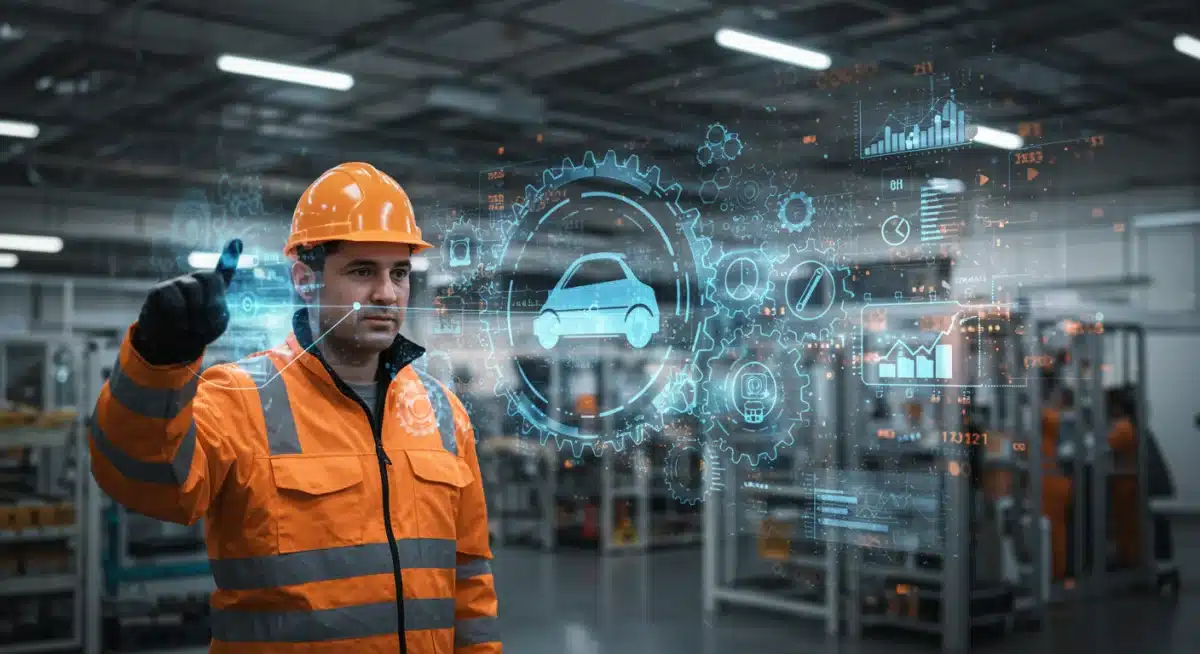
Localizing Production for Stability
The drive for supply chain localization is not merely about logistics; it’s a significant factor in labor market trends for 2025. By reducing reliance on overseas suppliers, companies aim to mitigate risks and stabilize production, which in turn supports domestic job growth.
- Battery Component Manufacturing: Significant investments are being made in US-based facilities for anode, cathode, and electrolyte production, creating specialized manufacturing jobs.
- Semiconductor Fabrication: While a longer-term endeavor, efforts to boost domestic semiconductor production will eventually lead to high-tech manufacturing roles.
- Raw Material Processing: Increased domestic processing of critical minerals like lithium and cobalt could establish new industrial sectors and job categories.
- Logistics and Distribution: A localized supply chain also strengthens demand for skilled labor in domestic transportation, warehousing, and logistics.
Demographic Shifts and Recruitment Challenges
The US auto industry faces ongoing demographic shifts, including an aging workforce and increasing competition for skilled talent. Attracting and retaining a diverse, technically proficient workforce is a significant challenge for 2025, especially given the specialized nature of EV manufacturing.
Many experienced workers are nearing retirement, taking with them decades of institutional knowledge. Simultaneously, younger generations are often drawn to other tech-centric industries, making it crucial for automotive companies to enhance their appeal through modern workplaces, competitive compensation, and clear career progression paths.
Attracting the Next Generation of Auto Workers
To combat demographic challenges, the industry must innovate its recruitment strategies, highlighting the exciting, high-tech aspects of modern automotive manufacturing. Showcasing opportunities for innovation and sustainability can appeal to a new cohort of talent.
Companies are actively engaging with STEM programs in schools and universities to foster interest in automotive careers from an early age. Internships and co-op programs provide valuable hands-on experience, converting academic knowledge into practical skills relevant to the industry’s future needs. Promoting diversity and inclusion also plays a key role in broadening the talent pool.
Government Policies and Economic Incentives
Government policies and economic incentives continue to play a critical role in shaping the US auto industry’s labor market for 2025. Federal and state initiatives aimed at promoting EV adoption, domestic manufacturing, and workforce development directly influence investment decisions and job creation.
Legislation such as the Inflation Reduction Act (IRA) includes significant tax credits and funding for EV manufacturing and battery production within North America. These incentives are designed not only to stimulate production but also to encourage high-wage job creation and union representation, aligning with broader economic development goals.
Impact of Federal and State Support
The strategic deployment of government funds and regulatory frameworks is a powerful lever for influencing labor market outcomes. These measures can accelerate the transition to new technologies and ensure that the benefits are broadly distributed across the workforce.
- Tax Credits for EV Production: Incentivize companies to build and expand EV and battery manufacturing facilities in the US, creating domestic jobs.
- Workforce Training Grants: Federal and state grants support programs designed to reskill and upskill workers for advanced manufacturing roles, bridging the skills gap.
- Infrastructure Development: Investments in charging infrastructure and smart grid technologies implicitly create jobs in construction, maintenance, and related service sectors.
- Buy American Provisions: Policies favoring domestically produced goods can strengthen demand for US-made auto components, supporting local manufacturing employment.
| Key Trend | Brief Description |
|---|---|
| EV Transition | Shifting skill demands from ICE to EV manufacturing, creating new jobs in battery and software. |
| Union Influence | UAW negotiations impacting wages, benefits, and job security, especially in new EV facilities. |
| Skills Gap | Increasing need for specialized training in EV technology, software, and advanced manufacturing. |
| Government Policy | Incentives and regulations driving domestic EV production and workforce development. |
Frequently Asked Questions About US Auto Labor in 2025
EV production is expected to gradually reduce demand for traditional internal combustion engine (ICE) manufacturing roles. However, it will simultaneously create new jobs requiring specialized skills in battery technology, software, and advanced electronics, prompting a workforce transition.
Labor unions, particularly the UAW, will continue to be critical. They are focused on ensuring fair wages, benefits, and job security for workers in new EV plants, pushing for union representation and addressing potential job displacement through collective bargaining.
Highly sought-after skills include expertise in battery technology, software development for vehicle systems, advanced robotics, and lightweight materials engineering. These reflect the industry’s pivot towards electric and autonomous vehicle manufacturing processes.
An aging workforce and competition for skilled talent pose significant challenges. The industry is actively working to attract younger, tech-savvy individuals through modern workplaces, competitive compensation, and clear career pathways in advanced manufacturing.
Federal and state policies, like the Inflation Reduction Act, are driving domestic EV manufacturing and battery production through tax credits and funding. These initiatives aim to create high-wage jobs and promote unionization within the evolving automotive sector.
Looking Ahead
The US auto industry’s labor market in 2025 is poised for continued transformation, driven by the relentless pace of electrification and automation. Stakeholders must remain agile, proactively addressing skill gaps, navigating complex union negotiations, and leveraging government incentives to foster a resilient and competitive workforce. The coming year will be crucial in defining the long-term trajectory of automotive employment, emphasizing the need for continuous adaptation and strategic investment in human capital as the industry evolves.

